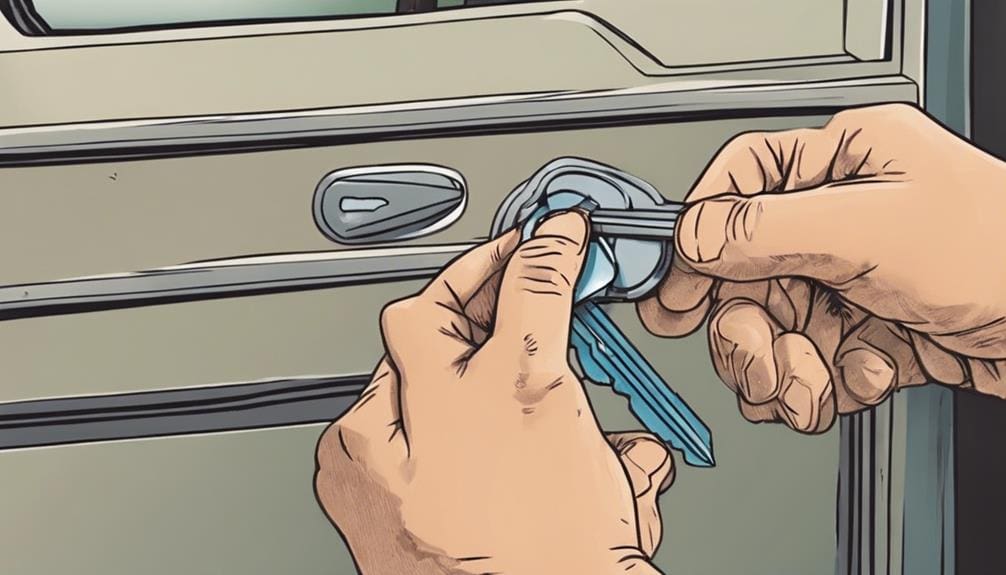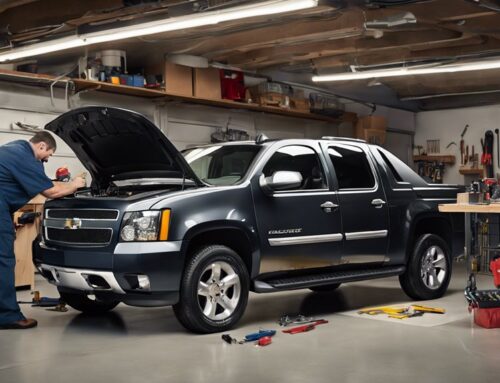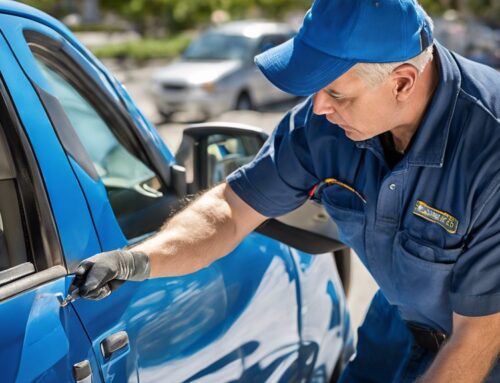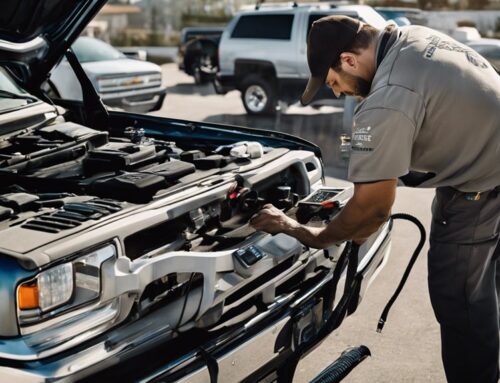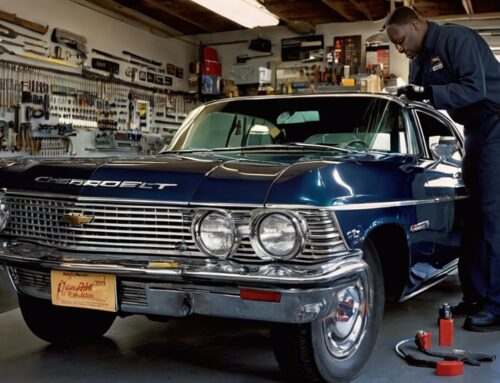First, identify where the key broke and inspect for visible fragments. Gather tools like needle nose pliers, tweezers, paperclips, and a lubricant (avoid oil-based). Spray lubricant into the lock, then align the cylinder. Use pliers or tweezers to gently extract the key, applying consistent pressure. If needed, straighten a paperclip to hook and pull the key out. Alternatively, press a heated glue stick against the key, let it cool, and pull gently. Avoid excessive force to prevent damage. If extraction seems difficult or risky, a locksmith might be necessary. Continue for detailed extraction techniques and considerations.
Key Takeaways
- Inspect the lock or ignition for visible fragments and determine the level of obstruction.
- Use needle nose pliers or tweezers to carefully extract visible key fragments without applying excessive force.
- Apply a dry graphite or Teflon-based lubricant to ensure smooth key fragment removal.
- Use a paperclip or bobby pin to hook and gently pull out the broken key piece.
- Consider calling a locksmith for complex locks or deeply embedded key fragments to avoid further damage.
Assess the Situation
Start by identifying exactly where the broken key is lodged, whether it’s in a door lock or a car ignition. This initial step is essential for determining the appropriate method to remove the broken key. Begin by inspecting the lock to see if the key is partially or fully broken and if any fragments are visible. If the broken piece is protruding from the lock, you might have an easier time removing it.
Next, assess the level of obstruction caused by the broken key. Determine if the broken key is causing the lock to be completely inoperable or if there’s still some movement. This will help you decide whether a simple DIY method will suffice or if you’ll need professional assistance.
Consider the type of lock you’re dealing with. Techniques to remove broken keys can vary significantly between a regular door lock and a car ignition. Car ignitions are generally more complex and may require different tools and approaches.
Gather Necessary Tools
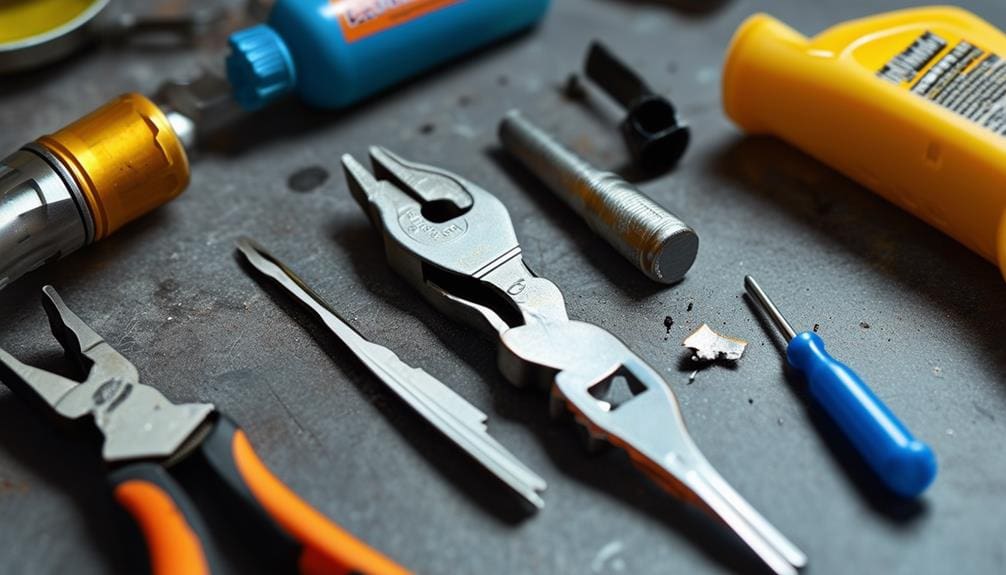
To begin, gather essential tools such as needle nose pliers, tweezers, and paperclips or bobby pins. Make sure you have a graphite or Teflon-based lubricant to ease the extraction process, avoiding oil-based options like standard WD-40. Proper preparation with these items notably enhances your chances of successfully removing the broken key.
Essential Extraction Tools
When you’re dealing with a broken key, having the right extraction tools on hand is crucial for a successful removal. You’ll need specific tools to make sure you can grip and extract the broken key fragment from a regular lock or car ignition efficiently.
The following table lists the essential tools and their uses:
| Tool | Usage |
|---|---|
| Pliers | Firmly grip and pull out the broken key |
| Tweezers | Reach into the lock and grasp the key piece |
| Paperclips | Manipulate the key fragment for extraction |
| Bobby Pins | Maneuver around the key piece to free it |
| Glue Stick | Melt, insert, and adhere to the broken key |
Needle nose pliers and tweezers are invaluable for providing a strong grip on the key fragment, enabling you to pull it out without harming the lock. Paperclips and bobby pins offer flexibility in maneuvering around the broken key piece, helping to shift it into a more accessible position.
For a different approach, a glue stick can be melted and carefully inserted into the keyhole. Once it adheres to the broken key, you can gently pull it out. This method requires caution to prevent damaging the lock.
Lubrication for Smooth Removal
Begin by gathering a dry graphite or Teflon/Silicone-based lubricant to make sure the lock is properly lubricated for smooth key extraction. These types of lubricants reduce friction and ease the process of broken key removal without causing harm to the lock. Avoid using oil-based lubricants like WD-40, as they can attract dirt and grime, potentially complicating future lock functionality.
Proper lubrication is essential for successful key removal. First, make sure you have your necessary tools ready: needle nose pliers, tweezers, paperclips, or bobby pins. Apply the lubricant by spraying or inserting it directly into the lock where the broken key is lodged. Allow the lubricant to penetrate for a few moments. This step guarantees the lock’s inner mechanisms are adequately coated, making it simpler for the broken key to slide out.
Once the lock is lubricated, use your chosen tool to gently grip and maneuver the broken key fragment. The lubrication will help reduce resistance, making the extraction process smoother and minimizing the risk of further harming the lock. Remember, patience and precision are essential; rushing can lead to complications.
DIY Vs. Professional Help
Assess the complexity of your broken key situation to decide if you should tackle the extraction yourself or seek professional locksmith assistance. Start by evaluating the level of difficulty involved. If the broken key is visible and accessible, DIY methods can be both cost-effective and convenient. You’ll need some basic tools:
- Needle nose pliers
- Tweezers
- Paperclips
- Small magnets
- Lubricant spray
Using these tools, you can carefully attempt to extract the key. However, if the key is deeply lodged or the lock mechanism is intricate, you might be better off contacting a professional locksmith. They possess specialized tools and the expertise needed for more challenging key removal tasks.
Consider the cost-effectiveness of each approach. DIY methods save money but come with potential risks, like damaging the lock further. On the other hand, hiring a professional locksmith may incur higher costs but guarantees a higher success rate and prevents additional damage.
Ultimately, choosing the right approach depends on the specific circumstances and your comfort level with the task at hand. Weigh the convenience, potential risks, and costs before deciding whether to proceed with DIY methods or enlist professional help.
Lubricate the Lock
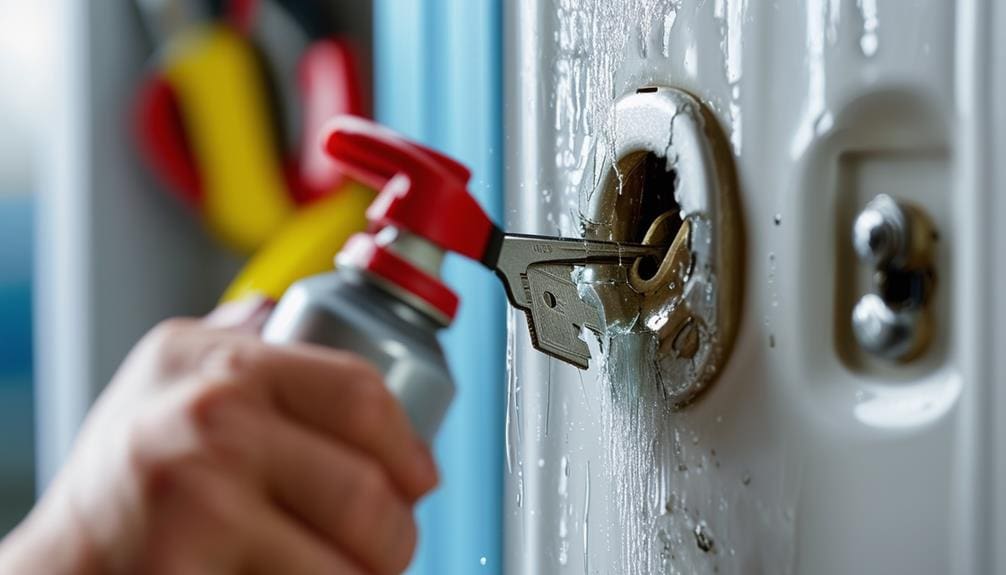
Start by selecting the appropriate lubricant for your lock; use graphite for indoor locks and Teflon or silicone-based lubricants for outdoor ones. Avoid oil-based lubricants like standard WD-40 to prevent attracting dirt. Apply the lubricant directly into the keyhole to reduce friction and ease the removal process.
Choose Appropriate Lubricant
Choosing the right lubricant, such as dry graphite or Teflon/Silicone-based options, is essential for reducing friction in the lock and guaranteeing a smoother key extraction process. Using an appropriate lubricant before attempting key removal can greatly increase your chances of success and prevent further damage to both the key and the lock.
When selecting a lubricant, keep the following points in mind:
- Dry graphite lubricants: These are excellent for friction reduction without attracting dust and debris.
- Teflon/Silicone-based lubricants: These provide a smooth coating that aids in lock lubrication without getting sticky over time.
- Avoid oil-based lubricants: Products like standard WD-40 can attract dust and debris, which may clog the lock.
- Verify compatibility: Check that the lubricant is suitable for use with the specific type of lock or ignition system.
- Ease of application: Choose a lubricant that is easy to apply and penetrates well into the lock mechanism.
Proper lubrication is a vital step in the key removal process. It helps reduce the friction between the broken key and the lock internals, making the extraction smoother and less prone to causing additional damage. By selecting the right lubricant, you can ensure efficient and trouble-free lock lubrication.
Apply Lubricant Correctly
Once you’ve selected the appropriate lubricant, apply it directly to the lock’s keyhole, making sure that it penetrates deeply into the mechanism. Start by shaking the lubricant can well if you’re using a spray. Insert the nozzle or straw into the keyhole and give it a short burst. This helps reduce friction within the lock, making the key extraction process smoother.
For indoor locks, dry lubricants like graphite are ideal. Insert the tube of graphite powder into the keyhole and gently squeeze to release the powder inside. Move the lock mechanism slightly to distribute the lubricant evenly.
For outdoor locks, opt for Teflon or Silicone-based lubricants. These are better suited for withstanding varying weather conditions and provide long-lasting lubrication. Spray a small amount into the keyhole and let it settle for a few moments.
Avoid using oil-based lubricants such as standard WD-40 because they can attract dirt and grime over time, potentially causing more issues. Proper lubrication is essential not only for successful key extraction but also for maintaining the lock’s integrity. By taking this step, you help prevent further damage and guarantee a smoother, more efficient key extraction.
Align the Cylinder
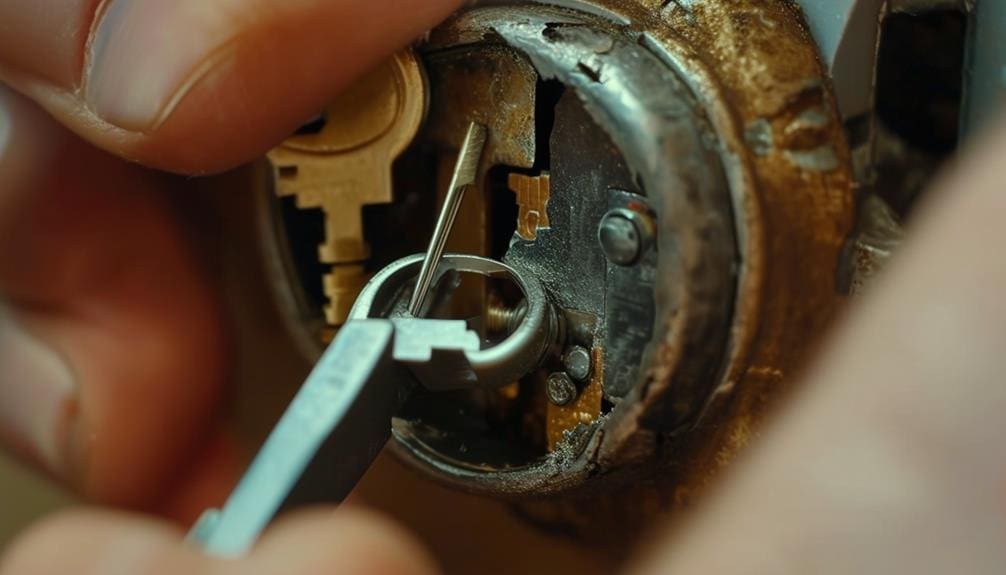
To align the cylinder properly, insert a paperclip or small screwdriver into the lock to gently rotate it until the cuts of the broken key point upward. This step is essential because when a working key is turned, red pins within the lock cylinder lock the key in place. Misalignment can cause the cylinder to lock, making key extraction impossible. Here’s a step-by-step guide to help you align the cylinder correctly:
- Insert the paperclip or screwdriver tip into the lock’s keyway.
- Gently apply pressure to rotate the cylinder.
- Observe the key position, ensuring the cuts of the broken key point upward.
- Avoid excessive force to prevent further damage to the lock cylinder.
- Check the alignment by ensuring the red pins are positioned at the shear line.
Rotating the cylinder carefully ensures the key’s cuts align correctly, facilitating easy removal. The red pins play a crucial role in this process, as they lock the key in place when misaligned. By adjusting the key position so that the cuts face upward, you create the best scenario for a successful extraction. This method guarantees the lock cylinder remains intact, preventing additional complications.
Use Pliers or Tweezers
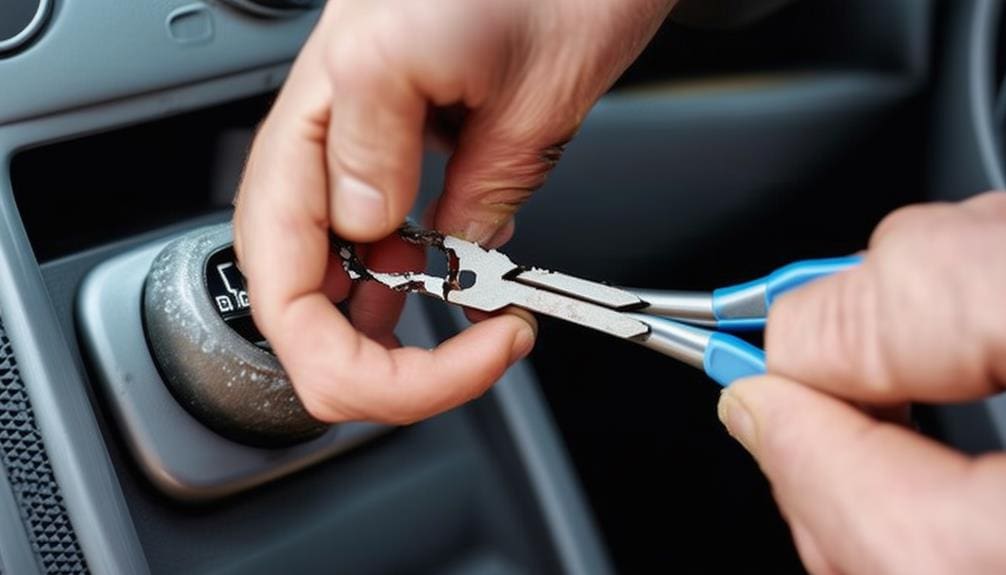
Using needle nose pliers or tweezers, grip the exposed part of the broken key firmly. Carefully and steadily pull the key out to prevent it from breaking further inside the lock. Verify you check for any remaining fragments after the extraction to avoid future issues.
Gripping the Key
Start by grasping the broken key firmly with needle nose pliers or tweezers, making sure you position them close to the base of the key for optimal control. This initial step is vital as it sets the stage for a successful extraction. Needle nose pliers are excellent due to their precision and strong grip, while tweezers with a thin, pointed tip can effectively reach into narrow keyways.
Maintain a consistent pressure as you hold the broken key to prevent further damage. A firm grip is necessary to avoid the key fragment from sliding back into the lock. Here are key points to keep in mind:
- Needle nose pliers: Offer a precise grip and are sturdy enough to handle the task.
- Tweezers with a pointed tip: Ideal for narrow keyways and provide good control.
- Position close to the base: Maximizes control and minimizes the risk of additional breakage.
- Consistent pressure: Essential to prevent pushing the key deeper into the lock.
- Firm grip: Stops the key from slipping and creating extra challenges.
Extracting With Precision
Why is it so important to use accuracy when extracting a broken key with pliers or tweezers? Accuracy is essential to prevent further damage to the lock or the remaining key fragment. Start by selecting needle nose pliers or fine tweezers, ensuring they’re clean and free of oil or debris.
First, gently insert the tool into the lock, aiming to grip the visible part of the broken key. With needle nose pliers, make sure you have a firm grip on the fragment without squeezing too hard, which could push it deeper into the lock. If using tweezers, position them carefully around the key fragment for best control.
Next, apply slow and steady movements. Avoid quick, jerky actions that could break the key further or damage the lock mechanism. Instead, pull the broken key towards you with a controlled, consistent motion. If you encounter resistance, do not force it. Pause, reassess your grip, and try again with slightly adjusted positioning.
Try a Wire or Paperclip
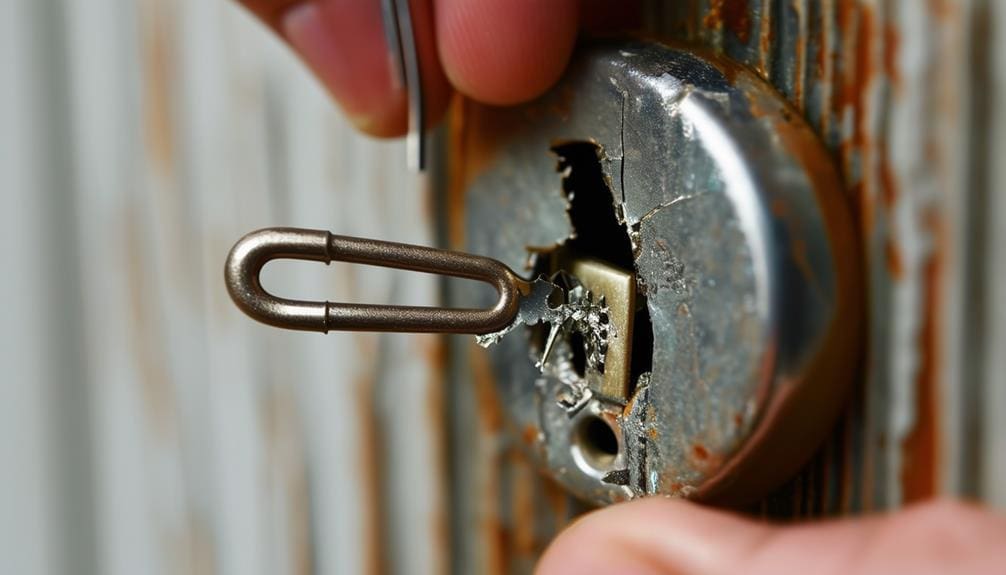
When facing the challenge of a broken key stuck in a lock, a thin, stiff wire or paperclip can be an effective tool to slide along the sides and extract the key fragment. This DIY method involves using a wire or paperclip to carefully hook onto the broken key piece and pull it out.
Here’s a step-by-step guide to help you through the process:
- Straighten the Wire or Paperclip: Start by straightening the wire or paperclip. If using a paperclip, unfold it completely.
- Create a Hook: Bend one end of the wire or paperclip to form a small hook. This hook will help you latch onto the broken key piece.
- Insert Along the Key: Carefully insert the hooked end of the wire or paperclip into the lock, sliding it along the sides of the broken key.
- Maneuver and Hook: Gently maneuver the wire or paperclip to hook onto the broken key piece. Be patient and avoid pushing the key further in.
- Pull Out the Key: Once the hook is secure, slowly pull the wire or paperclip out, bringing the broken key piece with it.
Using a wire or paperclip to extract a broken key is a simple, effective DIY technique that can save you time and money without needing professional help.
Employ a Glue Stick
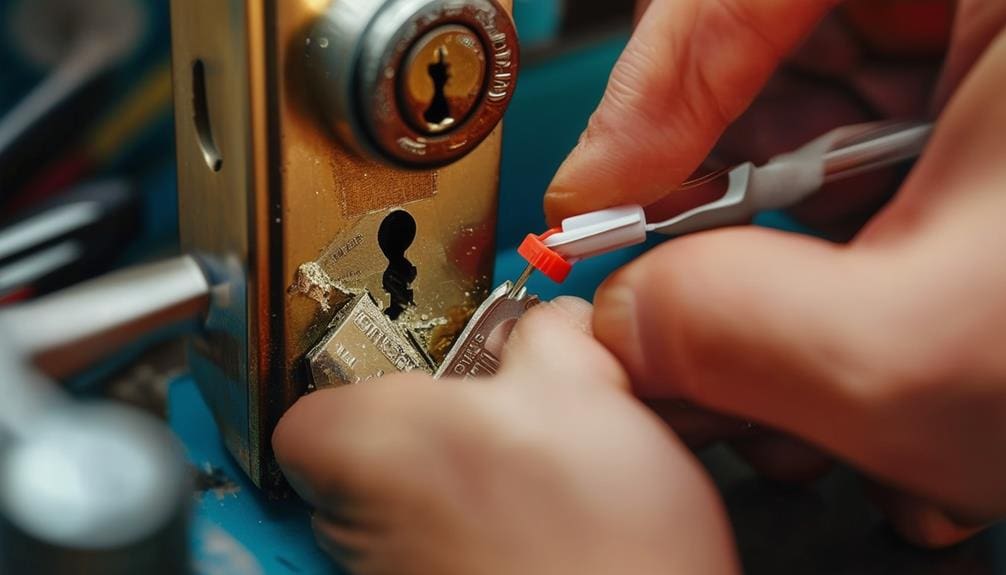
Have you ever considered using a glue stick to extract a broken key from a lock? This method is surprisingly effective and easy to carry out. First, take a standard glue stick and trim its edge to ensure a better grip and control during the process. Next, melt the tip of the glue stick using a lighter or another heat source. Be cautious not to overheat it, as this could make it too runny and difficult to manage.
Once the glue stick is adequately melted, carefully press it into the keyhole, making sure it makes contact with the broken key fragment. Hold it in place for a few moments, allowing the glue to cool and adhere firmly to the key. Avoid using super glue for this method, as it can seep into the lock mechanism and create more problems, making key extraction even more challenging.
After the glue has cooled and bonded to the key, gently pull the glue stick straight out. Hopefully, the broken key should come out with it. This technique works best when the broken key is close to the opening of the lock or car ignition.
Consider a Key Extractor
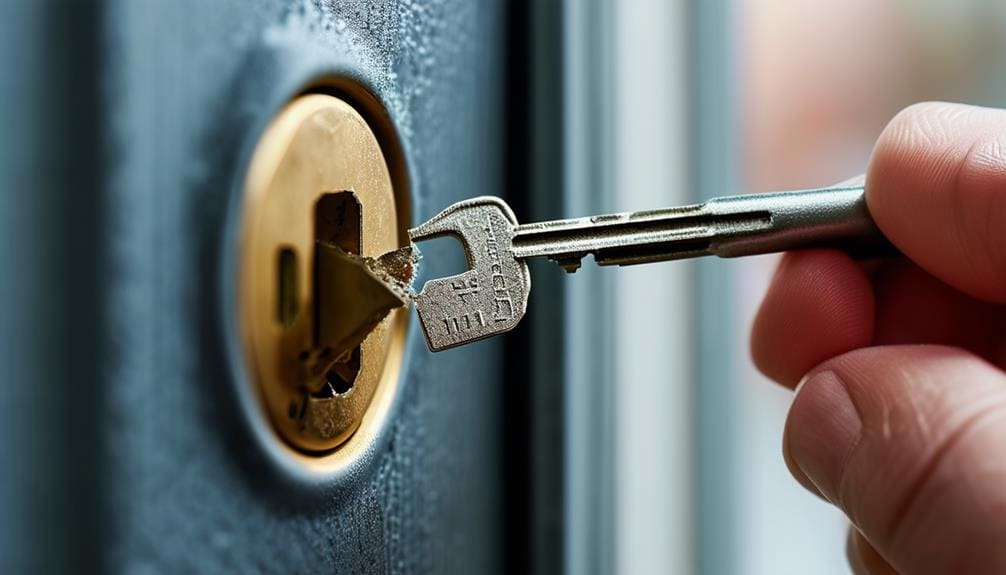
A key extractor is an invaluable tool that lets you securely grasp and remove broken key fragments from locks with precision. These specialized tools come in various sizes and designs, making them suitable for different types of keyways and broken key pieces. If you’re dealing with a broken key, using a key extractor can be a precise and effective method for extracting it, whether it’s a regular lock or a car ignition.
Here’s a step-by-step guide to using a key extractor:
- Select the Right Extractor: Choose an extractor that fits your lock’s keyway and the broken key fragment.
- Insert the Extractor: Carefully insert the extractor into the lock, aiming to catch the broken key.
- Secure Grip: Twist and maneuver the extractor to make sure it gets a secure grip on the broken key piece.
- Pull Out the Key: Once the extractor has a firm hold, gently pull it out to remove the broken key.
- Check for Damage: After removal, inspect the lock for any potential damage.
Locksmiths frequently use key extractors for their efficiency and reliability. With the right technique, you can remove the broken key without damaging your lock, saving both time and money.
Avoid Common Mistakes
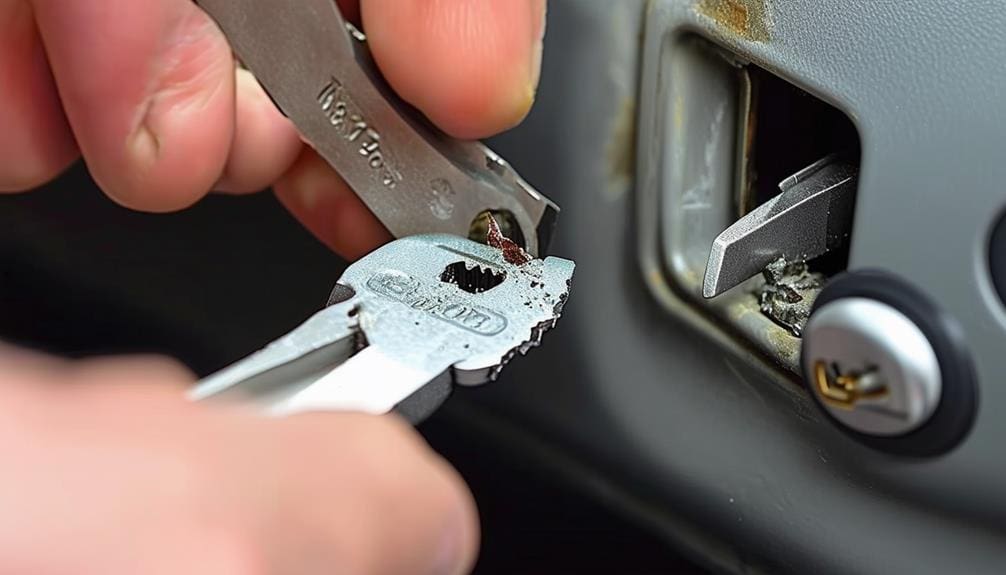
To avoid common mistakes during the extraction process, make sure you don’t push the broken key further into the lock. Doing so can make extraction notably more challenging. Instead, gently use needle nose pliers to grip any visible part of the broken key and carefully pull it out. Be patient and avoid using excessive force, as this can cause additional damage to the lock mechanism.
Another common mistake is trying to use super glue to extract the broken key. While it may seem like a quick fix, super glue can create a bigger issue if it gets stuck inside the lock. If you want to use a glue stick method, apply a small amount to the end of the broken key, wait for it to cool slightly, and gently pull the glue stick and key out together. This can make it easier, but it requires precision and caution.
If you’re unsure about any step in the extraction process or if the key remains stubbornly stuck, it’s wise to call a professional locksmith. They have the tools and expertise needed to safely remove the broken key without causing further harm.
When to Call a Locksmith
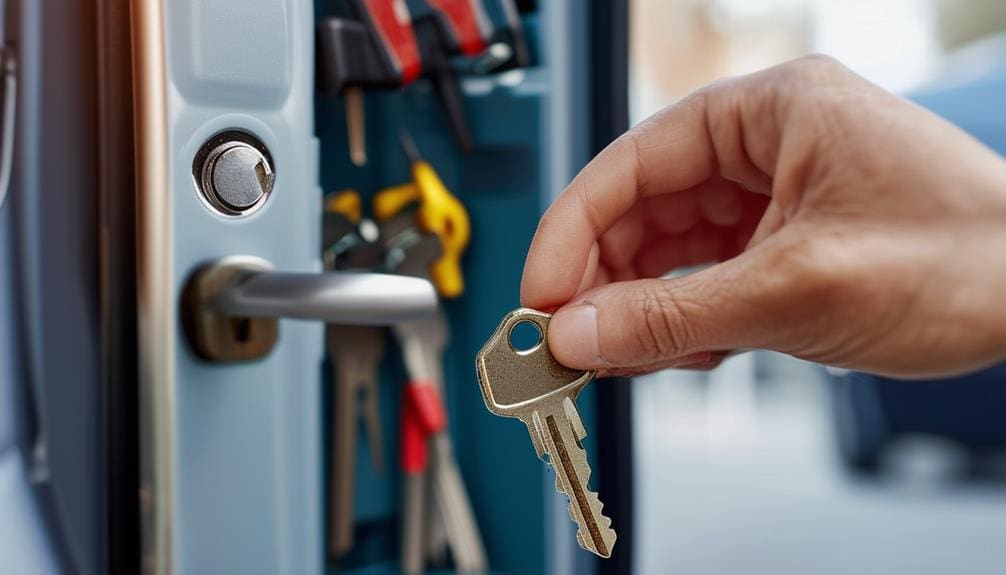
When DIY methods fail to remove a broken key, contacting a locksmith for professional assistance is crucial. Locksmiths have specialized tools and skills to manage intricate locks and difficult key extraction situations. Trying to extract a broken key without the proper expertise or key extraction tool can lead to further harm, adding complexity to the problem.
Consider reaching out to a locksmith in these situations:
- Intricate Locks: Contemporary locks often feature complex mechanisms that require expert attention.
- Embedded Fragments: If key pieces are stuck deeply, a locksmith can securely dislodge them.
- Preventing Damage: Skilled locksmiths can avert additional harm to your lock or ignition.
- Time-Efficient: Professional locksmith services are effective, saving you time and annoyance.
- Economical: While the average cost is approximately $160, it may be more affordable than replacing a damaged lock.
A locksmith’s proficiency guarantees the swift and secure removal of the broken key. By utilizing the appropriate key extraction tools, they can handle even the most stubborn broken keys. Hence, when uncertain, always contact a locksmith to evade unnecessary complications and ensure a successful key extraction.
Frequently Asked Questions
How to Get a Snapped Key Out of a Car Ignition?
To tackle ignition repair for a snapped key, start with DIY extraction using needle nose pliers. If broken key solutions fail, apply these locksmith tips: avoid pushing the key further. Consider car key replacement if necessary.
How Do You Remove a Key That Has Snapped in the Lock?
Imagine you just broke a key in a lock. First, lubricate the lock, then use DIY methods with key extraction tools like tweezers. If unsuccessful, avoid further damage and consider locksmith services to prevent key breakage.
How to Remove Key From Car Ignition?
To tackle ignition key extraction, start with DIY key removal methods like using needle nose pliers or key extraction tools. Apply lubricant for easier removal. If broken key solutions fail, seek locksmith assistance for professional help.
What to Do if a Car Key Is Broken?
When a car key breaks, suspense builds as you consider broken key extraction from the car door. Try DIY methods like tweezers or a glue stick. If these fail, seek professional locksmith assistance for safe key removal.
Conclusion
You’ve successfully solved the snag and secured your sanity. By evaluating the situation, assembling the appropriate tools, and applying lubrication, you’ve laid the groundwork. Aligning the cylinder, using pliers or tweezers, and experimenting with a glue stick or key extractor are vital steps. Avoiding common mistakes and knowing when to call a locksmith are essential. Remember, patience and precision pay off. So, keep calm and carry on; your key conundrum is now a conquered challenge!

